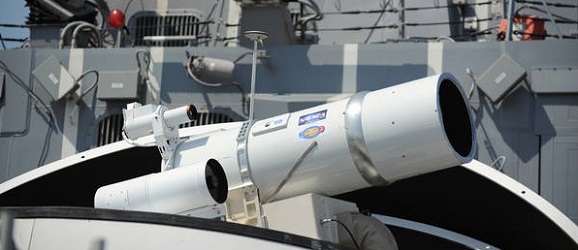Navy Got Lasers! Navy Got Lasers!
This article is more than 2 years old
 The U.S.S. Ponce is an amphibious transport and docking ship in the Persian Gulf, where the Iranian navy hasn’t exactly been forthcoming in their pleasantries. Iran’s navy tends to fall between two camps: one comprised of older, larger ships; and a guerilla-style fleet of speedboats equipped with machine guns. And so what will the U.S.S. Ponce have installed on it at some point in 2014? Oh, nothing, just a fucking fully-functional laser is all. And it’s probably a tad more powerful than the one curing addiction in rats.
The U.S.S. Ponce is an amphibious transport and docking ship in the Persian Gulf, where the Iranian navy hasn’t exactly been forthcoming in their pleasantries. Iran’s navy tends to fall between two camps: one comprised of older, larger ships; and a guerilla-style fleet of speedboats equipped with machine guns. And so what will the U.S.S. Ponce have installed on it at some point in 2014? Oh, nothing, just a fucking fully-functional laser is all. And it’s probably a tad more powerful than the one curing addiction in rats.
The announcement was made by the chief of naval operations, Adm. Jonathan W. Geenert, whose intentions were probably two-fold, if not more so. Give the American people something as cool as lasers to look forward to, and give Iran something to hesitate over.
The laser is multi-functional. It can burn its way through those fast-attack boats, as well as the unmanned drones that Iran is currently producing. The laser burst doesn’t have to be lethal, however, and also can perform a “dazzle” attack that will cause sensors to go haywire while everything else stays intact. “Whoa, why is that picture frame floating across the room? Is it a poltergeist?” Nah, dude, the Navy got lasers. Check it out in action below and imagine how much damage 21-laser salutes will cause in the future of military mourning.
The Congressional Research Service stepped in as a non-partisan onlooker, making sure the U.S. Navy wasn’t just blowing smoke in everyone’s eyes, and they were certainly impressed, saying the laser “could provide Navy surface ships with more cost-effective means of countering certain surface, air, and ballistic missile targets.” How cost-effective? Compare the $1.4 million it costs for short-range air-defense interceptor missiles to the cost to shoot a sustained pulse of laser energy: less than $1. Granted, I’m sure they’ll find a way to make it tons more expensive somehow, perhaps by strapping sharks to the lasers, but this is still a remarkable achievement for the American military. So what’s the educational equivalent to a laser, and how can we get it in our schools?












